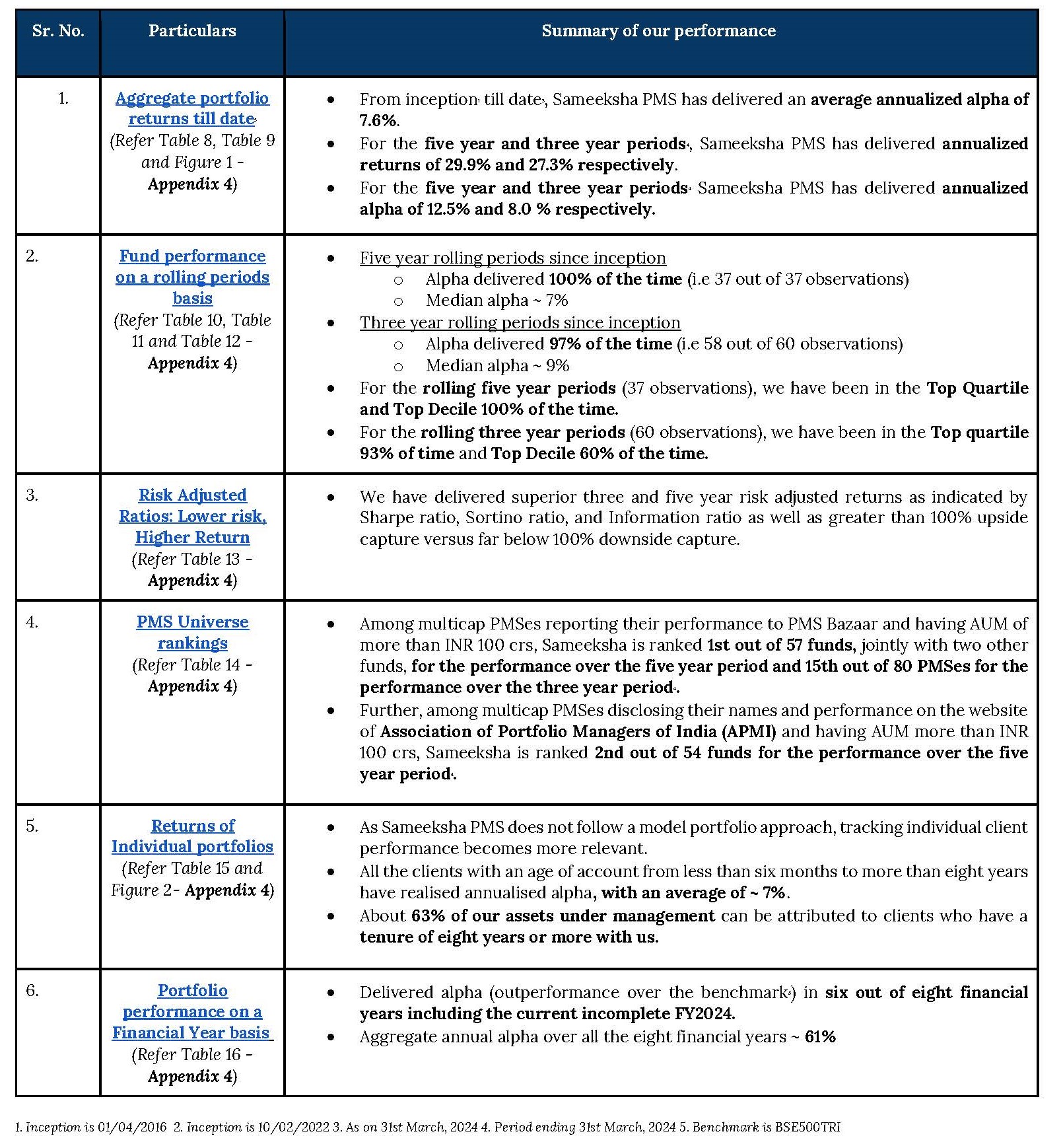As Sameeksha has completed eight years of operating the PMS, it is worth reviewing eight key aspects of our performance.

Aggregate Portfolio Returns over various time periods
Sameeksha PMS has delivered a substantial aggregate annual alpha of 61.0% over BSE500 TRI over the eight financial years implying an average annual alpha of 7.6% since inception (Table 8).

It is important to note that we have maintained relatively higher levels of cash (13% on average over the entire period from inception) from time to time over the duration of managing the portfolio. Notwithstanding the same, from inception, over five years and over three years respectively, we have generated returns of 23.4%, 29.9% and 27.3% in INR terms and 20%, 25.3% and 21.9% in USD terms thus generating substantial alpha over the Indian benchmark BSE500 TRI returns and SPY ETF (ETF tracking US S&P 500 index), respectively. Also, we have delivered strong returns relative to benchmark across various key time periods (Table 9 and Figure 1).


Aggregate Portfolio Performance and ranking on a rolling periods basis
Rolling returns are a more useful indicator of consistency in performance versus single period returns. For rolling three year periods applicable to our entire operating history, Sameeksha PMS has delivered aggregate annualized alpha 97% of the times (58 out of 60 observations) ranging from 0.4% to 23%. For the rolling five year periods applicable, Sameeksha PMS has delivered aggregate annualized alpha 100% of the times (37 out of 37 observations) ranging from 5% to 16% (Table 10).

For the rolling three year periods applicable to our entire operating history, we have been ranked among the multicap universe in the Top Decile 60% of the time (36 out of 60 observations) and in the Top Quartile 93% of the time (56 out of 60 observations). For the remaining 7% observations, we were ranked in the Second Quartile (Tables 11 and 12). For the rolling five year periods applicable for our entire operating history, we have been ranked among the multicap universe in the Top Decile 100% of the time (37 out of 37 observations).


Risk Adjusted Ratios
When compared on a risk adjusted basis, our PMS has shown an even stronger performance. The Information Ratio (IR) measures the excess return of a portfolio over a benchmark per unit of active risk. A higher Information Ratio (IR) suggests better risk-adjusted performance. The Sortino ratio measures the risk-adjusted return of an investment, focusing only on the downside risk. A higher Sortino ratio indicates better risk-adjusted returns, particularly with respect to downside risk.
Moreover, Upside Capture measures how well a fund performs as compared to a benchmark when the benchmark has positive returns. A higher upside capture ratio (> 100%) indicates that the fund captures more of the benchmark’s positive movements. Whereas, Downside Capture measures how well a fund performs compared to a benchmark when the benchmark has negative returns. A lower downside capture ratio (< 100%) indicates that the fund preserves capital better during market downturns. Furthermore, other risk-adjusted returns measures such as Sharpe ratio and Information Ratios are strong (Table 13).

Performance within the PMS Universe
We continue to maintain our top rankings both within the multicap PMS universe as well as the entire PMS universe for key periods of three and five years. The multicap PMS universe rankings are more relevant to us since we follow the multicap strategy.
In the interest of a fair comparison, we present our rankings among those multicap PMSes with AUM more than INR 100 crs. Within this universe, we are 1st out of 57 PMSes, jointly with two other PMSes, for the five year period and 15th out of 80 PMSes for three year period, highlighting our superior performance over the long term periods (Table 14). Among the multicap universe (considering all AUM), we are consistently ranked in the Top Decile for the five year period for all 36 out of 36 observations reflecting well on the consistency of our performance.

Returns of Individual Portfolios
Because we don’t follow model portfolio strategy, the performance of individual clients is far more important than overall portfolio aggregate returns (Table 15 and Figure 2). For investors who are with us for 3 years and more, Sameeksha PMS has returned a very substantial alpha with an average annualized alpha of approx. 6.8% for the three year period ending 31st March, 2024. Similarly, for investors who are with us for 5 years or more, Sameeksha PMS has returned substantial alpha with an average annualized alpha of approx. 12.4% for the five year period ending 31st March, 2024. The Figure below shows the average annualized returns and alpha over different periods of time of all the clients as on 31st March, 2024.

Long term investors, mainly investor accounts older than 5 years and 3 years, have carved out strong alpha, thereby proving Sameeksha PMS to be a valuable partner for their investments (Table 15).

Aggregate Portfolio Performance on a Financial Year basis
For the current financial year ending March 2024 (April 2023 to March 2024), Sameeksha PMS has outperformed the benchmark BSE 500 TRI by generating 60.1% returns against the benchmark BSE500TRI returns of 40.2% (Table 16). Discerning investors would notice that we have delivered this performance despite maintaining a meaningful percentage of our portfolio in cash from time to time and that is well reflected in our risk-adjusted-performance outcomes.

Cumulative Performance versus the benchmark
Sameeksha’s outperformance over its benchmark has continued to widen positively over the years. An investment of Rs. 100 with us since inception (April 2016) would have grown to Rs. 538, far outpacing what one would have earned by investing in a fund that achieved benchmark returns (Figure 3).

Links:-
Appendix 1: Performance of the fund for FY2024
Appendix 2: Key Performance Contributors in FY2024
